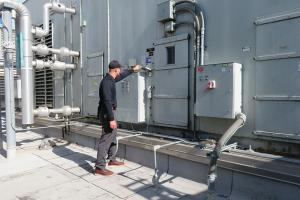Building resiliency becomes a priority for organizations
 |
| Health care facilities can take steps to become more structurally resilient against adverse weather like hurricanes. Photo by Stocktrek Images/Thinkstock |
Making health care facilities and all buildings as resilient as possible against high-impact weather events has become a common cause for organizations ranging from the leading construction and design trade groups to the American Meteorological Society (AMS).
The catastrophic damage caused by hurricanes Sandy and Katrina and the wave of tornadoes that struck the central United States three years ago, among other events, has served as an impetus to make buildings as strong as possible.
With input from builders, engineers, urban planners, architects and others related to health care facility construction and operation, the AMS Policy Program recently issued a report that can help health care facilities to increase their resiliency during and after high-impact weather such as hurricanes and tornadoes.
According to the AMS report, the strategy to build resiliency involves a process that starts with understanding and managing a facility's risk, finding solutions to possible weaknesses and preparing for the continuity of health services even when disrupted.
"The strategy involves a risk-management approach of dealing with the risks one faces by understanding the high-impact weather threats, identifying the vulnerabilities for their facility and operations and then dealing with those vulnerabilities. So, one is figuring out the potential problems and two is figuring out the solutions," says Shalini Mohleji, senior policy fellow, AMS Policy Program, and director of the resiliency study and related workshop that generated the report.
The study offers three different approaches to making health care facilities more resilient: hardening structures, incremental adaptations and innovative practices. The best approach is determined by resources available to each facility.
For example, after its hospital in Joplin, Mo., was destroyed by a tornado in 2011, Mercy is planning to install windows that can withstand winds of 250 mph in its new facilities, she says.
Because hospitals commonly put high-cost clinical equipment or HVAC equipment in basements or lower levels, it can make them vulnerable to flooding, if that is an identified risk. Building flood walls or moving the equipment to a higher floor are potential solutions, the report says.
Reducing the vulnerabilities posed by power outages from weather can be addressed by adding renewable energy systems to a facility's energy mix.
The report encourages facilities to stock extra supplies of pharmaceuticals, linens and other nonperishable items and to develop a communication network with other local health care systems, public agencies and businesses, so it can sustain clinical services for as long as possible.
In a separate event, the opening of an exhibit at the National Building Museum, Washington, D.C., called Designing for Disaster served as a backdrop for a statement issued by more than 20 U.S. construction, engineering and design groups regarding their commitment to promoting and researching resiliency in buildings.
"We recognize that natural and man-made hazards pose an increasing threat to the safety of the public and vitality of our nation," the statement says in part. "We further recognize that contemporary planning, building materials, design, construction and operational techniques can make our communities more resilient to these threats."
Similarly, the AMS study is the third in a series looking at community resilience and the overlap of health and weather. AMS has worked with the National Oceanic and Atmospheric Administration and National Weather Service, which is researching how to make communities more resilient.




